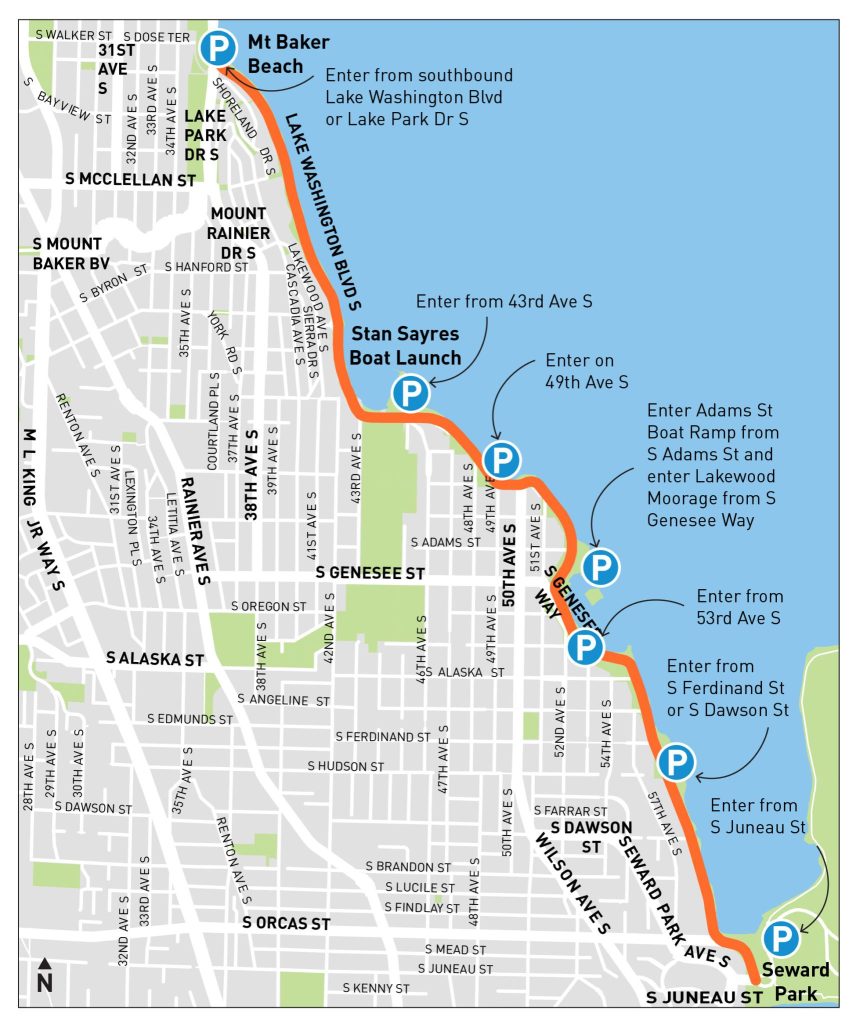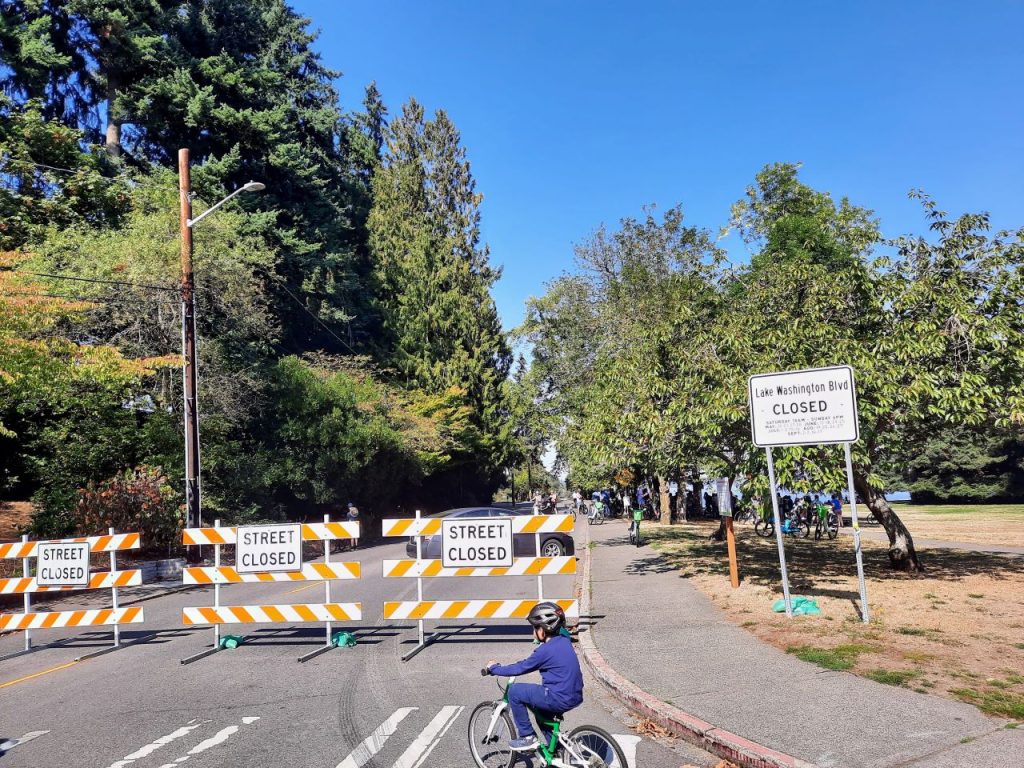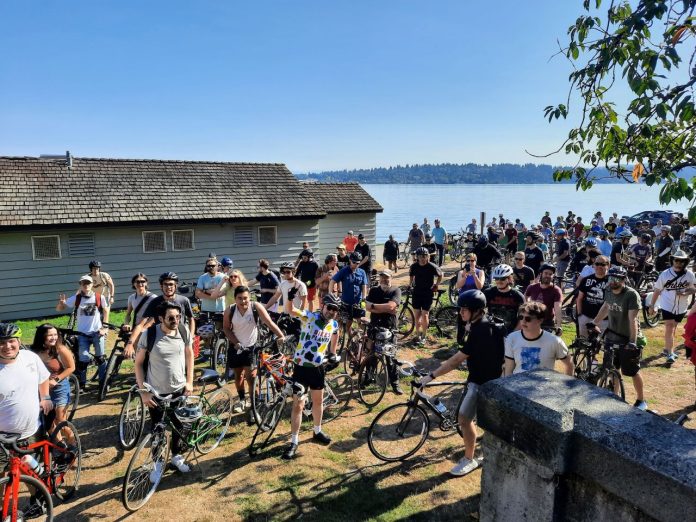Featured guest Ray Delahanty of CityNerd was a big fan of the Lake Washington Boulevard open street.
On Saturday, The Urbanist hosted a bike ride and meetup along Lake Washington Boulevard with Ray Delahanty of the popular CityNerd YouTube channel. The turnout blew us away, with more than 200 people joining the festivities. Taking place during the last weekend that Lake Washington Boulevard was an open street for the 2023 season, the event underscored that Lake Washington Boulevard should be pedestrianized year-round, with car access restricted like it was this weekend.
While the City of Seattle closed the three-mile segment of Lake Washington Boulevard to cars for much of the summer of 2020, and every weekend in 2021 as a Covid response measure, it has since reverted to the limited weekend closure/open street routine of pre-pandemic times. The Seattle Department of Transportation (SDOT) and Seattle Parks hosted 10 car-free open street weekends on the boulevard in 2023.

From fall through spring, riders will have to bide their time or risk their lives on a corridor where speeding is rampant and motorists routinely make unsafe passes. And it’s certainly not like a wealth of alternative routes for people biking and rolling exist through the area, given the dearth of safe streets infrastructure and a number of delayed safety projects in Southeast Seattle.

Surveys have repeatedly shown that the open street on Lake Washington Boulevard is wildly popular and widely supported, but the Harrell administration has remained hesitant to change the status quo car dominance of the street. Since 2020, The Urbanist editorial board has urged the City to make the pedestrianization permanent.
Our event Saturday with Delahanty showed how great Lake Washington Boulevard can be when it’s swarmed by people biking, rolling, walking, and relaxing instead of people speeding in their cars and crowding out everyone else. If the crowd gathered were in cars, we literally would not have fit in the streets, as pointed out by Jason Rock of Rainier Valley Greenways and Safe Streets (a local chapter of Seattle Neighborhood Greenways, a safe streets advocacy powerhouse).
Can't imagine how bad the traffic would be if people were driving instead pic.twitter.com/UN0Mg5WNBP
— Jason (@Jrock08) September 16, 2023
A 200-strong procession of people biking (plus that one guy solo-wheeling) fit easily in the street. In the absence of the threat and noise of cars, people noticed the calm, the quiet, and the beauty of Lake Washington. It was simply magical, especially on a sunny September day — a time when a Puget Sounder aches to pluck the last fruits of summer before the long gray of winter.
This was an incredibly cool event. Thanks to @UrbanistOrg for organizing, and it was amazing to have so many Seattle folks show up on a day when you could’ve been doing literally ANYTHING else https://t.co/S9oHtsdl4Z
— Ray Delahanty (@Nerd4Cities) September 17, 2023
Terry Holme with Rainier Valley Greenways and Safe Streets plugged the group’s ongoing campaign to pedestrianize Lake Washington Boulevard to ride attendees. That effort has had to patiently press on through an endless labyrinth of Seattle Process, with never-ending outreach and surveys and hapless task forces and studies. Holme urged people to keep submitting comments and urging the City to follow through.
Visit the Seattle Parks engagement hub on “Lake Washington Boulevard Renovations Project” or email project lead Jordon Hoy (Jordan.Hoy@seattle.gov) to comment.

People biking have been spinning their wheels trying to extend the program since the very first Bicycle Sunday in 1968. Seattle Parks closed the same three-mile stretch of Lake Washington Boulevard to cars expecting perhaps a few hundred to show up. Between 5,000 and 10,000 people turned out, as Seattle Bike Blog‘s Tom Fucoloro recounts in his new book “Biking Uphill in the Rain: The Story of Seattle from Behind the Handlebars.”
That massive turnout in 1968 put biking on the map for Seattle officials, jumpstarting an era of progress that brought biking out of the shadows and gradually led to the creation of real bike infrastructure. It also left us with a legacy of Bicycle Sundays on Lake Washington that have continued ever since. But the idea of making the pedestrianization permanent has never gained traction and the broader progress toward making streets safe for all has repeatedly run into headwinds, delay tactics, and obstructive litigation.
Saturday’s event was a homecoming for Delahanty who grew up in Seattle before moving to Portland to launch his urban planning career. He now lives in Albuquerque. In 2021, Ray took what turned out to be a permanent sabbatical from urban planning to launch the CityNerd YouTube channel. Check out my interview with Delahanty for more.
It is awesome to see @Nerd4Cities holding court. pic.twitter.com/dMXpERIIQI
— Qagggy! (@Qagggy) September 16, 2023
CityNerd has now grown to more than 200,000 subscribers. It’s a great follow with weekly videos tackling issues like housing affordability, urban design, walkability, and more. Delahanty said that Seattle is his top metropolitan area for followers which is another indication of how hungry Seattle area residents are for walkable streets, bike facilities, and urbanism in general.
The Urbanist (capital U) effect https://t.co/GsrcuUWV8y
— Ray Delahanty (@Nerd4Cities) September 17, 2023
A special thanks to Machine House Brewing, which hosted the afterparty and meet and greet with Ray. Our group stretched thin the bike parking in the area and the capacity of the brewery, but with a little creativity and grace every bike fit and everybody got a cold beverage after a beautiful day on a car-free boulevard. One could get used to this.
Doug Trumm is publisher of The Urbanist. An Urbanist writer since 2015, he dreams of pedestrian streets, bus lanes, and a mass-timber building spree to end our housing crisis. He graduated from the Evans School of Public Policy and Governance at the University of Washington in 2019. He lives in Seattle's Fremont neighborhood and loves to explore the city by foot and by bike.


